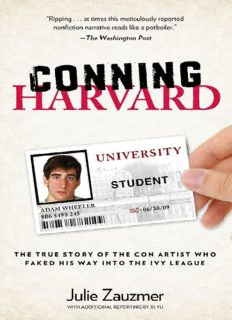
Conning Harvard: Adam Wheeler, the Con Artist Who Faked His Way into the Ivy League (Additional reporting) PDF
Preview Conning Harvard: Adam Wheeler, the Con Artist Who Faked His Way into the Ivy League (Additional reporting)
CONNING HARVARD CONNING HARVARD Adam Wheeler, the Con Artist Who Faked His Way into the Ivy League J Z ULIE AUZMER With additional reporting by Xi Yu Dedicated to all those who uphold Harvard’s standards Copyright © 2012 by Julie Zauzmer ALL RIGHTS RESERVED. No part of this book may be reproduced or transmitted in any form by any means, electronic or mechanical, including photocopying and recording, or by any information storage and retrieval system, except as may be expressly permitted in writing from the publisher. Requests for permission should be addressed to Globe Pequot Press, Attn: Rights and Permissions Department, PO Box 480, Guilford, CT 06437. Lyons Press is an imprint of Globe Pequot Press. Some of the reporting and research for this book was funded by and conducted for The Harvard Crimson. Such materials are used here with permission. Project editor: Meredith Dias Layout: Mary Ballachino Library of Congress Cataloging-in-Publication Data Zauzmer, Julie. Conning Harvard : Adam Wheeler, the con artist who faked his way into the Ivy League / Julie Zauzmer ; with additional reporting by Xi Yu. p. cm. Summary: “Conning Harvard tells the story of Adam Wheeler’s lie-filled path into Harvard, his compulsive conning of grant and scholarship boards after enrolling, and the eventual discovery of his fraudulent past”—Provided by publisher. ISBN 978-0-7627-8743-2 (hardback) 1. Cheating (Education)—United States. 2. Wheeler, Adam (Adam B.) 3. Harvard University—Students. 4. Harvard University—Funds and scholarships. 5. Swindlers and swindling—United States. I. Yu, Xi. II. Title. LB3609.Z38 2012 378.1’98—dc23 2012018145 CONTENTS Copyright Introduction Prologue Chapter One Chapter Two Chapter Three Chapter Four Chapter Five Chapter Six Chapter Seven Chapter Eight Chapter Nine Acknowledgments Endnotes To indicate as explicitly as possible the instances where the author could not know the exact words spoken by the participants in this story, some dialogue in this book appears without quotation marks. That dialogue should be read as the author’s effort, based on statements made by one or more participants in each conversation, to reconstruct actual conversations in the manner most faithful to the likely words exchanged between the speakers. INTRODUCTION This book chronicles an academic fraud of stunning proportions. Over a period of six years, Adam B. Wheeler tricked the smartest institutions in the country time and time again. He plagiarized application essays to get into one of the country’s best liberal arts colleges. He stole a Pulitzer Prize winner’s work to win a poetry prize. Then he took on Harvard University—the world’s most recognized institution of higher education, whose very name has meant prestige, privilege, excellence, and exclusivity for centuries. Adam Wheeler was an expert forger and a skillful liar with seemingly few scruples about fabricating his academic credentials whenever the occasion arose. In snagging admission to Harvard, he unfairly attained an honor that millions of students worldwide dream of. In striving to scam institutions at the pinnacle of higher education—Yale, Brown, Stanford, the Rhodes and Fulbright scholarships, and more—he astonished the nation with the story of his audacity. Many were outraged that he took a precious spot at Harvard that could have gone to an honest applicant, not to mention thousands of dollars in prizes that selection committees could have bestowed on deserving young scholars. Others were impressed by his skillful cons or even smugly amused to see Harvard outsmarted for once. But whether one perceives him as the hero or the villain of his tale, this ultimately is not about Adam Wheeler. His fraudulent path is extraordinary, but on its own, his story is unimportant. What is important is that high school students today face unprecedented pressure when it comes to college admissions. What is important is that as many as 14 percent of essays are plagiarized, 50 percent of transcripts are faked, and 90 percent of recommendation letters are forged among some groups of college applicants. What is important is that a generation of teenagers, raised in an
Description: